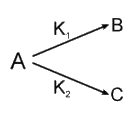दो अभिक्रियाओं के दर स्थिरांक नीचे दिए गए हैं। उनकी अभिक्रिया की कोटि की पहचान कीजिए ।
(i)k=6.3×10−2Lmol−1s−1
(ii)k=2.8×10−4s−1
A
(i) द्वितीय कोटि, (ii) प्रथम कोटि
B
(i) प्रथम कोटि, (ii) द्वितीय कोटि
C
(i) शून्य कोटि, (ii) प्रथम को
D
(i) द्वितीय कोटि, (ii) शून्य को
Text Solution
The correct Answer is:A
द्वितीय कोटि के लिए, दर स्थिरांक की इकाई
=molL−1s×1(molL−1)2
=mol−1Ls−1
प्रथम कोटि के लिए, दर स्थिरांक की इकाई
=molL−1s×1molL−1=s−1
|
Topper's Solved these Questions
Similar Questions
The rate for the decomposition of NH3 on platinum surface is zero order. What are the rate of production of N2 and H2 if K=2.5×10−4mollitre−1s−1?
View SolutionThe rate constant for the reaction
2N2O5→4NO2+O2,is 3.0×10−5S−1. If the rate is
2.40×10−5molL−1s−1 then the concentration of
N2O5(in molL−1) is
View Solution
Knowledge Check
A+2B→C+D. If −d[A]dt=5×10−4 mol L−1s−1, then −d[B]dt is :
A2.5×10−4mol.l−1s−1B5×10−4mol.l−1s−1C2.5×10−3mol.l−1s−1D1×10−3mol.l−1s−1The value of log10K for a reaction A⇔B is (Given: ΔfHΘ298K=−54.07kJmol−1,
ΔrSΘ298K=10JK=1mol−1, and R=8.314JK−1mol−1A5B10C95D100In a catalytic conversion of N2 to NH3 by Haber's process, the rate of reaction was expressed as change in the concentration of ammonia per time is 40×10−3molL−1s−1. If there are no side reaction, the rate of the reaction as expressed in terms of hydrogen is (in mol L−1s−1)
A60×10−3B20×10−3C1200D10.3×10−3

